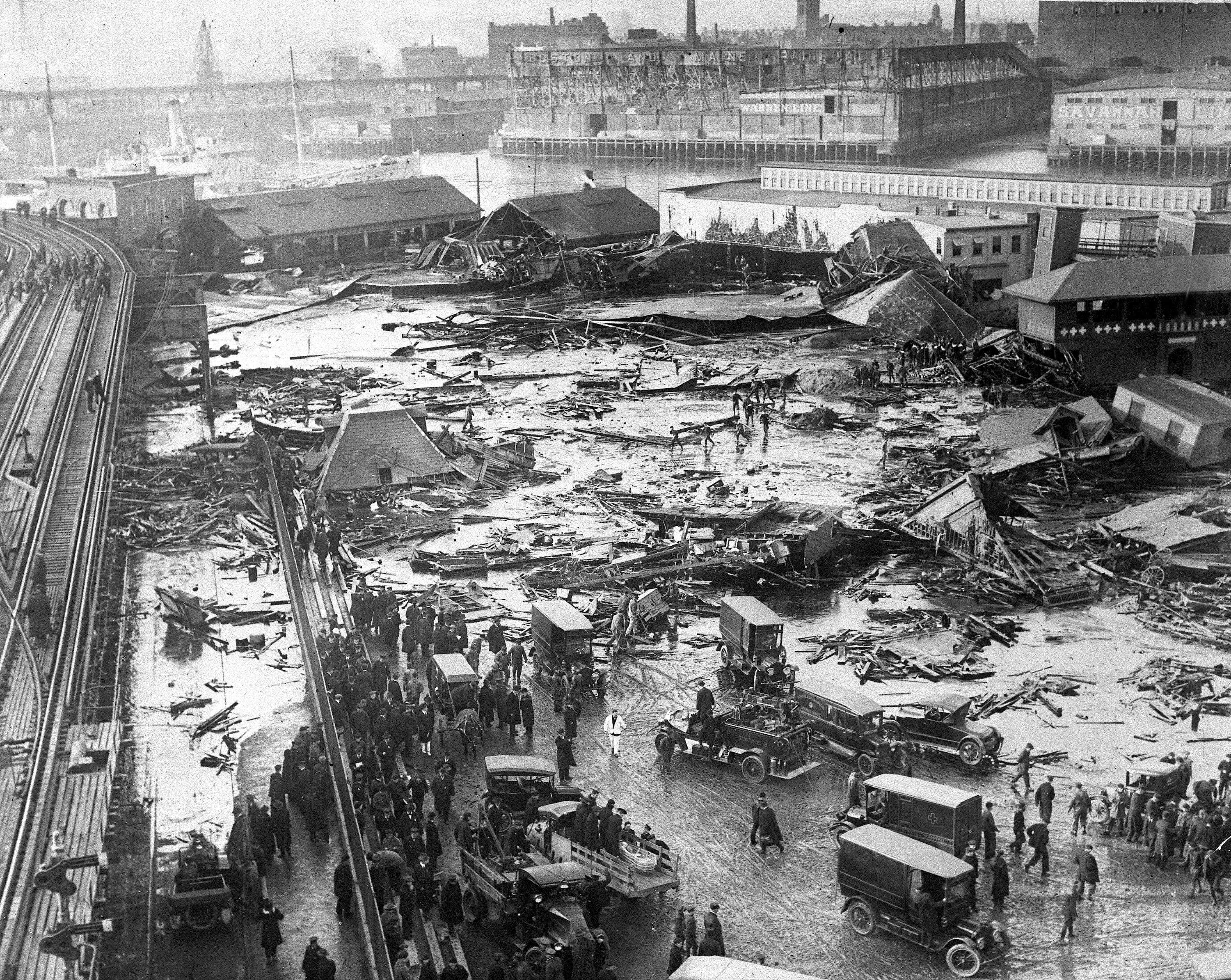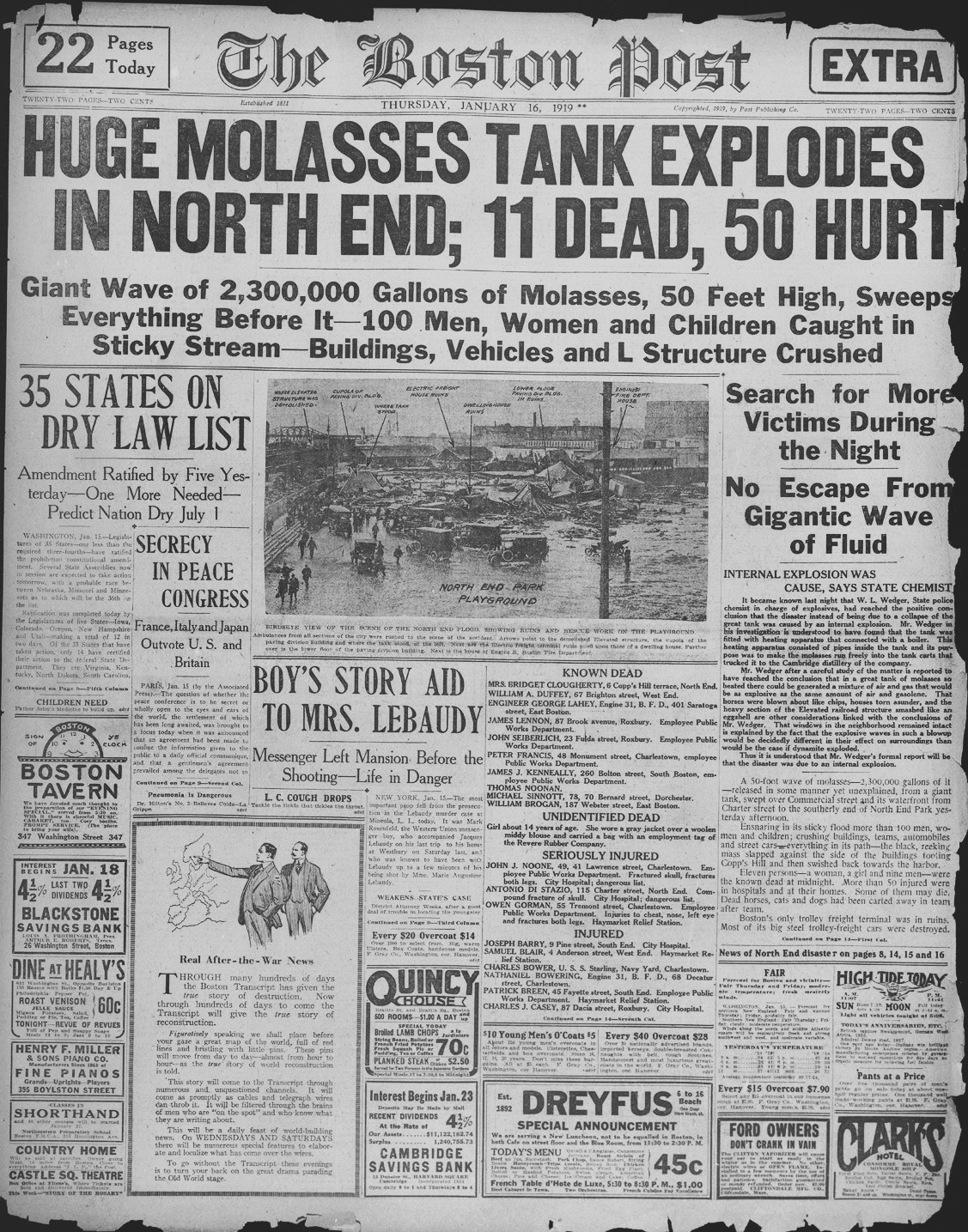General Discussion
Related: Editorials & Other Articles, Issue Forums, Alliance Forums, Region Forums100 Years Ago Today; Great Molasses Flood of Boston kills 21

The Great Molasses Flood, also known as the Boston Molasses Disaster or the Great Boston Molasses Flood, occurred on January 15, 1919 in the North End neighborhood of Boston, Massachusetts. A large storage tank filled with 2.3 million gallons (8706 tons) of molasses burst and a wave of molasses rushed through the streets at an estimated 35 mph (56 km/h), killing 21 and injuring 150. The event entered local folklore and residents claimed for decades afterwards that the area still smelled of molasses on hot summer days.

Flood
The disaster occurred at the Purity Distilling Company facility on January 15, 1919. The temperature had risen above 40 °F (4 °C), climbing rapidly from the frigid temperatures of the preceding days.
Molasses can be fermented to produce rum and ethanol, the active ingredient in other alcoholic beverages and a key component in the manufacturing of munitions. The stored molasses was awaiting transfer to the Purity plant situated between Willow Street and what is now named Evereteze Way, in Cambridge.
At about 12:30 in the afternoon near Keany Square, at 529 Commercial Street, a molasses tank 50 ft (15 m) tall, 90 ft (27 m) in diameter, and containing as much as 2,300,000 US gal (8,700 m3), collapsed. Witnesses variously reported that as it collapsed they felt the ground shake and heard a roar, a long rumble similar to the passing of an elevated train (coincidentally, with a line of that type close by), a tremendous crashing, a deep growling, or "a thunderclap-like bang!", and as the rivets shot out of the tank, a machine gun-like sound.
Molasses is about 1.5 times denser than water, so the stored molasses had a great deal of potential energy. The collapse translated this energy into a wave of molasses 25 ft (8 m) high at its peak, moving at 35 mph (56 km/h). The molasses wave was of sufficient force to damage the girders of the adjacent Boston Elevated Railway's Atlantic Avenue structure and tip a railroad car momentarily off the tracks. Author Stephen Puleo describes how nearby buildings were swept off their foundations and crushed. Several blocks were flooded to a depth of 2 to 3 ft (60 to 90 cm). Puleo quotes a Boston Post report:
Molasses, waist deep, covered the street and swirled and bubbled about the wreckage ... Here and there struggled a form?—?whether it was animal or human being was impossible to tell. Only an upheaval, a thrashing about in the sticky mass, showed where any life was ... Horses died like so many flies on sticky fly-paper. The more they struggled, the deeper in the mess they were ensnared. Human beings?—?men and women?—?suffered likewise.
The Boston Globe reported that people "were picked up by a rush of air and hurled many feet." Others had debris hurled at them from the rush of sweet-smelling air. A truck was picked up and hurled into Boston Harbor. After the initial wave, the molasses then became viscous, exacerbated by the cold temperatures, trapping those caught in the wave and further making it difficult to rescue them. About 150 people were injured; 21 people and several horses were killed. Some were crushed and drowned by the molasses, or the debris it carried within. The wounded included people, horses, and dogs; coughing fits became one of the most common ailments after the initial blast. In a 1983 article for Smithsonian, Edwards Park wrote of one child's experience:
Anthony di Stasio, walking homeward with his sisters from the Michelangelo School, was picked up by the wave and carried, tumbling on its crest, almost as though he were surfing. Then he grounded and the molasses rolled him like a pebble as the wave diminished. He heard his mother call his name and couldn't answer, his throat was so clogged with the smothering goo. He passed out, then opened his eyes to find three of his four sisters staring at him.
</snip>
Casandia
(656 posts)He was born and raised in Boston, and was an eye witness for this disaster. He was Irish, it was tough for him to get descent employment. One day General Motors opened a recruiting office in Boston, and he was hired on the spot and was sent to work in Flint, Michigan. The molasses story was one of the several stories he would tell the family.
Thanks for posting this!
whistler162
(11,155 posts)kiri
(796 posts)The molasses went down between all the cobble stones and into the sewers and wharfs. On hot summer days, you can still smell the molasses.
malaise
(269,174 posts)First I'm hearing about this.
2naSalit
(86,794 posts)learned about it from my grandparents back in the 60s. Local legend that nearly everyone in New England heard about while growing up.
Tarc
(10,476 posts)
Javaman
(62,534 posts)once upon a time, prior to building something, architects and engineers didn't have to sign and seal their documents or drawings for a project. That means, if something fucked up, no one was basically held responsible and many a time was blamed on an "act of god".
The Great Molasses Flood of Boston changed all of that.
since then, all documents have to be completely reviewed before being released. that means a design firm or engineering firm can now be held libel in the event of an accident; major or minor.
I work at an Arch firm and everything is thoroughly vetted prior to being signed and sealed for construction.
If you ever see a set of arch or engineering drawings, look down in the right lower corner. there should be a seal with a signature on it (with the date of issuance). if not, those drawings are just the prelims and not for construction.